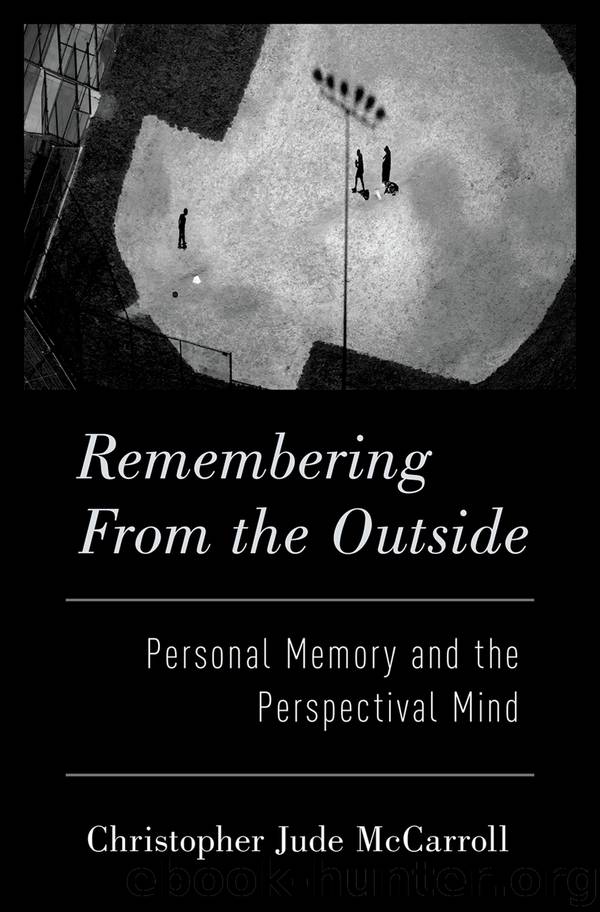Remembering from the Outside by McCarroll Christopher;

Author:McCarroll, Christopher;
Language: eng
Format: epub
Publisher: Oxford University Press USA - OSO
Published: 2018-05-15T00:00:00+00:00
The result, Benson tells us, leaves us with the “experiential correlates of no ‘point of view’ ” (2001: 199). Benson provides samples of the comments left by those who experienced the Ganzfeld Sphere. Here are a few examples: “I felt the colours inside my head, rather than around me”; “the sensation of being behind my eyelids”; “seeing the colours behind your eyes amazing” (Benson 2001: 199, emphasis original).
An important point to note here is that this piece by Turrell creates the conditions that dissolve the boundaries of inside/outside, here/there, by, in part, removing visible objects, and hence the corresponding point of view on those objects. By drawing on Turrell’s work, Benson shows the importance of objects to the notion of a point of view. If we use this insight and emphasize the Sartrean view that mental imagery does not involve viewing an object inside one’s head, then the worries about requiring a point of view may also dissipate. Mental imagery may be a way of thinking about some object or event, rather than viewing an object in one’s mind. If the mental image is not an object in consciousness, then one does not need to occupy a point of view and experience seeing it. Although the experiences Turrell evokes with his art are no doubt contrived and vanishingly rare, it does at least hint at the possibility of experiencing no point of view even in perception. And this, combined with the Sartrean notion that the image is not an object in consciousness, puts further pressure on the idea that mental imagery must involve an occupied point of view and the experience of seeing.
In order to develop his claim about the perspectival nature of imagery involving the experience of seeing, Martin invokes Campbell’s notion of monadic egocentric spatial terms. Recall that, for Campbell, monadic egocentric spatial terms are more primitive than relational spatial terms, and do not specify the person standing in a spatial relation to the objects. When monadic spatial terms are used, the self is an unarticulated constituent, so to speak, in the spatial relation to objects.18 For Martin, both vision and visualizing involve monadic egocentric spatial notions, which relate to an occupied but not explicitly represented point of view, and hence visualizing involves imagining seeing (2002: 410). Given that vision involves a field perspective, all visualizing, for Martin, must also involve a field perspective—an occupied point of view. This, however, seems much too constraining for the imagination.
Martin himself points to the fact that the monadic egocentric spatial notions of visualizing do not play exactly the same role as those of vision: “For in imagining something as to the left one does not thereby imagine as in one’s actual environment on the left”; instead, he continues, “the perspectival aspect of one’s visualising should relate not to one’s actual situation, but rather to the imagined situation” (Martin 2002: 410, emphasis original). Martin’s point about the different role of monadic egocentric spatial terms in vision and visualizing relates to Campbell’s conception of causal indexicality.
Download
This site does not store any files on its server. We only index and link to content provided by other sites. Please contact the content providers to delete copyright contents if any and email us, we'll remove relevant links or contents immediately.
The remains of the day by Kazuo Ishiguro(8388)
Tools of Titans by Timothy Ferriss(7810)
Giovanni's Room by James Baldwin(6808)
The Black Swan by Nassim Nicholas Taleb(6762)
Inner Engineering: A Yogi's Guide to Joy by Sadhguru(6439)
The Way of Zen by Alan W. Watts(6288)
Asking the Right Questions: A Guide to Critical Thinking by M. Neil Browne & Stuart M. Keeley(5355)
The Power of Now: A Guide to Spiritual Enlightenment by Eckhart Tolle(5331)
The Six Wives Of Henry VIII (WOMEN IN HISTORY) by Fraser Antonia(5235)
Astrophysics for People in a Hurry by Neil DeGrasse Tyson(5000)
12 Rules for Life by Jordan B. Peterson(4160)
Housekeeping by Marilynne Robinson(4059)
The Ethical Slut by Janet W. Hardy(4036)
Skin in the Game by Nassim Nicholas Taleb(3965)
Double Down (Diary of a Wimpy Kid Book 11) by Jeff Kinney(3923)
Ikigai by Héctor García & Francesc Miralles(3889)
The Art of Happiness by The Dalai Lama(3844)
Skin in the Game: Hidden Asymmetries in Daily Life by Nassim Nicholas Taleb(3720)
Walking by Henry David Thoreau(3681)
